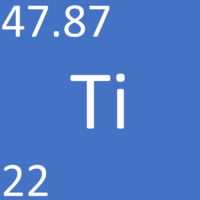Difference between revisions of "Titanium"
(Created page with "==Key Stage 2== ===Meaning=== Titanium is a metal. ==Key Stage 3== ===Meaning=== right|300px|thumb|The [[Chemical Symbol|chemical symbol fo...") |
|||
| (4 intermediate revisions by 2 users not shown) | |||
| Line 4: | Line 4: | ||
==Key Stage 3== | ==Key Stage 3== | ||
===Meaning=== | ===Meaning=== | ||
| − | [[File: | + | [[File:TitaniumSymbol1.png|right|300px|thumb|The [[Chemical Symbol|chemical symbol]] for [[Titanium]].]] |
[[Titanium]] is a [[Transition Metal|transition metal]] [[element]], on the [[Periodic Table]], with an [[Atomic Number|atomic number]] of 22. | [[Titanium]] is a [[Transition Metal|transition metal]] [[element]], on the [[Periodic Table]], with an [[Atomic Number|atomic number]] of 22. | ||
| Line 21: | Line 21: | ||
: [[Titanium]] is [[ductile]]. | : [[Titanium]] is [[ductile]]. | ||
==Key Stage 4== | ==Key Stage 4== | ||
| + | [[File:TiKS4.PNG|right|200px|thumb|The [[Chemical Symbol|chemical symbol]] for [[Titanium]].]] | ||
===Meaning=== | ===Meaning=== | ||
[[Titanium]] is a [[Transition Metal|transition metal]] [[element]], on the [[Periodic Table]], with 22 [[proton]]s in the [[Atomic Nucleus|nucleus]]. | [[Titanium]] is a [[Transition Metal|transition metal]] [[element]], on the [[Periodic Table]], with 22 [[proton]]s in the [[Atomic Nucleus|nucleus]]. | ||
| − | ===About | + | ===About Titanium=== |
====Molecular Structure==== | ====Molecular Structure==== | ||
: [[Titanium]] has the [[Chemical Formula|chemical formula]] [[Titanium |Ti]]. | : [[Titanium]] has the [[Chemical Formula|chemical formula]] [[Titanium |Ti]]. | ||
| Line 30: | Line 31: | ||
: The most [[Stable Isotope|stable isotope]] of [[Titanium]] has 26 [[neutron]]s in its [[Atomic Nucleus|nucleus]] giving it an [[Relative Atomic Mass|atomic mass]] of 48. | : The most [[Stable Isotope|stable isotope]] of [[Titanium]] has 26 [[neutron]]s in its [[Atomic Nucleus|nucleus]] giving it an [[Relative Atomic Mass|atomic mass]] of 48. | ||
: [[Titanium]] is in [[Period]] 4 of the [[Periodic Table]] because it has 4 [[Electron Orbital|electron shells]]. | : [[Titanium]] is in [[Period]] 4 of the [[Periodic Table]] because it has 4 [[Electron Orbital|electron shells]]. | ||
| + | : [[Titanium]] loses [[electron]]s to form [[Positive Charge|positive]] [[Metal Ion|metal ions]]. | ||
====Properties==== | ====Properties==== | ||
| + | : [[Titanium]] forms [[Ionic Bond|ionic bonds]] with [[non-metal]]s. | ||
: [[Titanium]] is a [[metal]] [[element]] so it is a good [[Thermal Conductor|thermal conductor]] and a good [[Electrical Conductor|electrical conductor]]. | : [[Titanium]] is a [[metal]] [[element]] so it is a good [[Thermal Conductor|thermal conductor]] and a good [[Electrical Conductor|electrical conductor]]. | ||
: [[Titanium]] is a shiny [[solid]] at [[STP|standard temperature and pressure]] and has a high [[Melting Point|melting point]]. | : [[Titanium]] is a shiny [[solid]] at [[STP|standard temperature and pressure]] and has a high [[Melting Point|melting point]]. | ||
| Line 36: | Line 39: | ||
: [[Titanium]] is [[sonorous]]. | : [[Titanium]] is [[sonorous]]. | ||
: [[Titanium]] is [[ductile]]. | : [[Titanium]] is [[ductile]]. | ||
| + | |||
| + | ===References=== | ||
| + | ====AQA==== | ||
| + | |||
| + | :[https://www.amazon.co.uk/gp/product/0008158762/ref=as_li_tl?ie=UTF8&camp=1634&creative=6738&creativeASIN=0008158762&linkCode=as2&tag=nrjc-21&linkId=a0fffa35b3ea49a63404f6704e0df7cc ''Titanium, dioxide nanoparticles, page 86, GCSE Chemistry; Student Book, Collins, AQA ''] | ||
| + | :[https://www.amazon.co.uk/gp/product/0008158762/ref=as_li_tl?ie=UTF8&camp=1634&creative=6738&creativeASIN=0008158762&linkCode=as2&tag=nrjc-21&linkId=a0fffa35b3ea49a63404f6704e0df7cc ''Titanium, pages 79, 341, GCSE Chemistry; Student Book, Collins, AQA ''] | ||
Latest revision as of 11:09, 5 March 2020
Contents
Key Stage 2
Meaning
Key Stage 3
Meaning
Titanium is a transition metal element, on the Periodic Table, with an atomic number of 22.
About Titanium
Molecular Structure
- Titanium has the chemical symbol Ti.
- Titanium atoms join together in large numbers to form a giant metal molecule.
Atomic Structure
- Titanium as 22 protons and 26 neutrons in its nucleus giving it an Atomic Number of 22 and an atomic mass of 48.
- Titanium is in Period 4 of the Periodic Table because it has 4 electron shells.
Properties
- Titanium is a metal element so it is a good thermal conductor and a good electrical conductor.
- Titanium is a shiny solid at room temperature.
- Titanium is malleable.
- Titanium is sonorous.
- Titanium is ductile.
Key Stage 4
Meaning
Titanium is a transition metal element, on the Periodic Table, with 22 protons in the nucleus.
About Titanium
Molecular Structure
- Titanium has the chemical formula Ti.
- Titanium atoms join together in a giant metallic structure.
Atomic Structure
- The most stable isotope of Titanium has 26 neutrons in its nucleus giving it an atomic mass of 48.
- Titanium is in Period 4 of the Periodic Table because it has 4 electron shells.
- Titanium loses electrons to form positive metal ions.
Properties
- Titanium forms ionic bonds with non-metals.
- Titanium is a metal element so it is a good thermal conductor and a good electrical conductor.
- Titanium is a shiny solid at standard temperature and pressure and has a high melting point.
- Titanium is malleable.
- Titanium is sonorous.
- Titanium is ductile.

